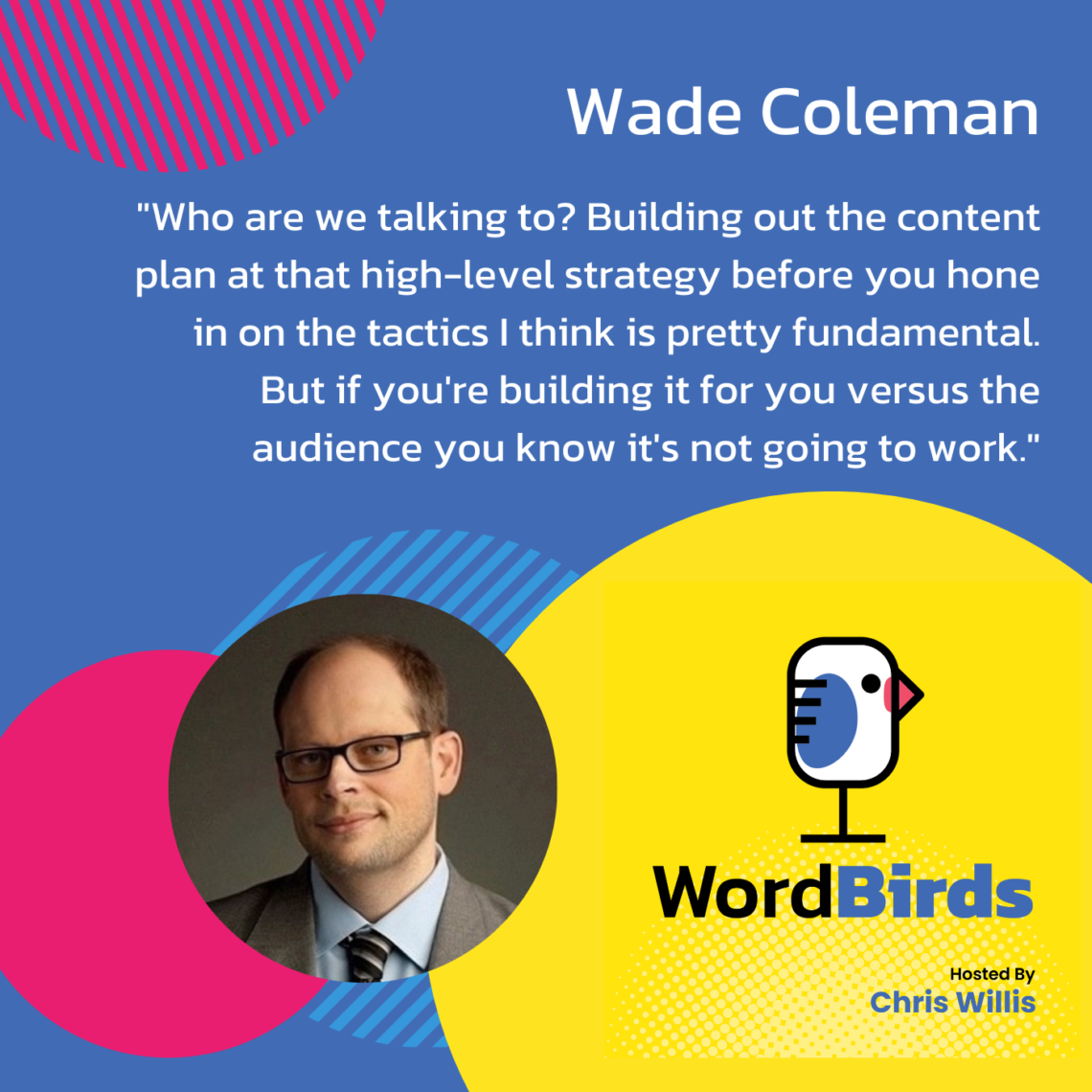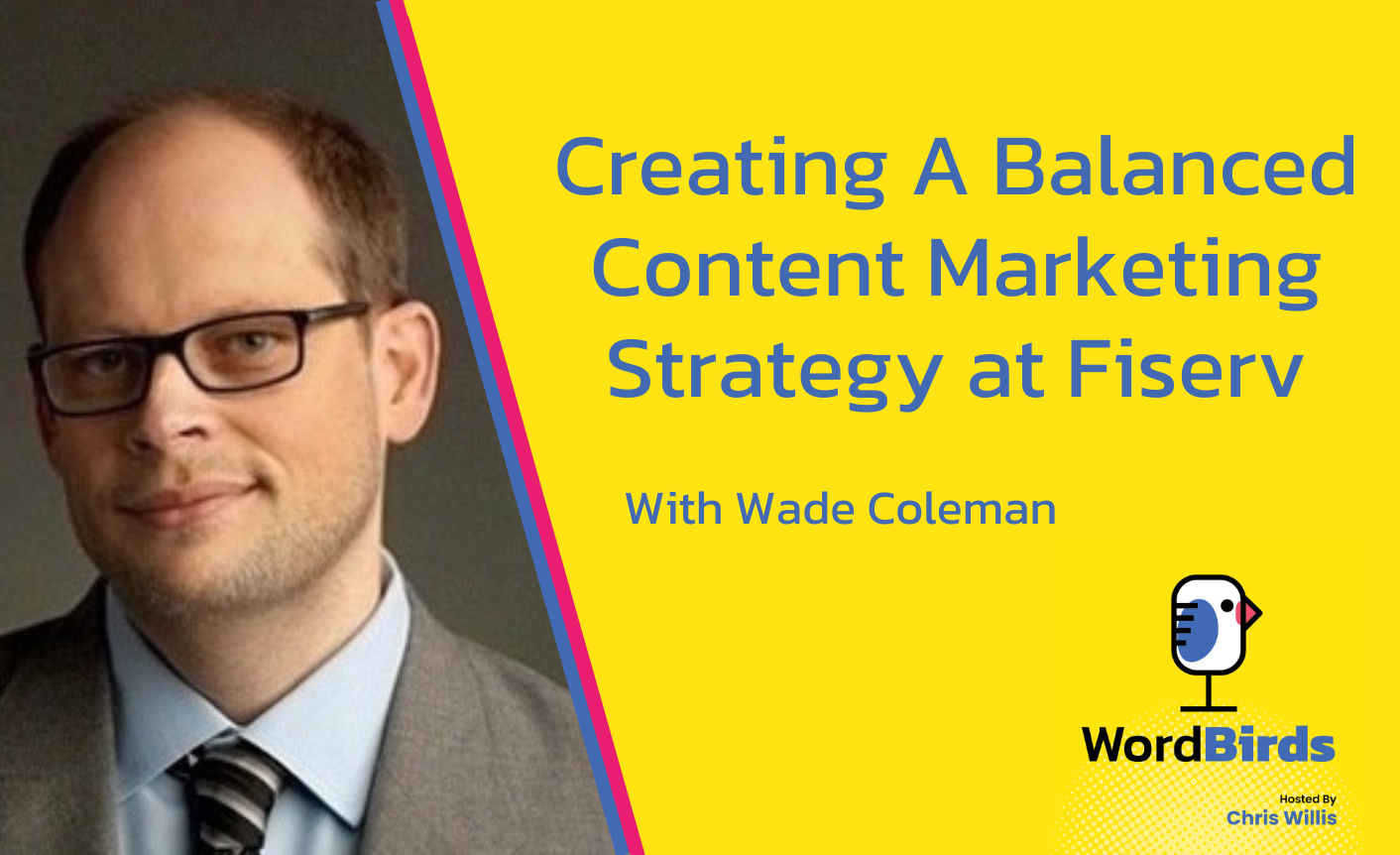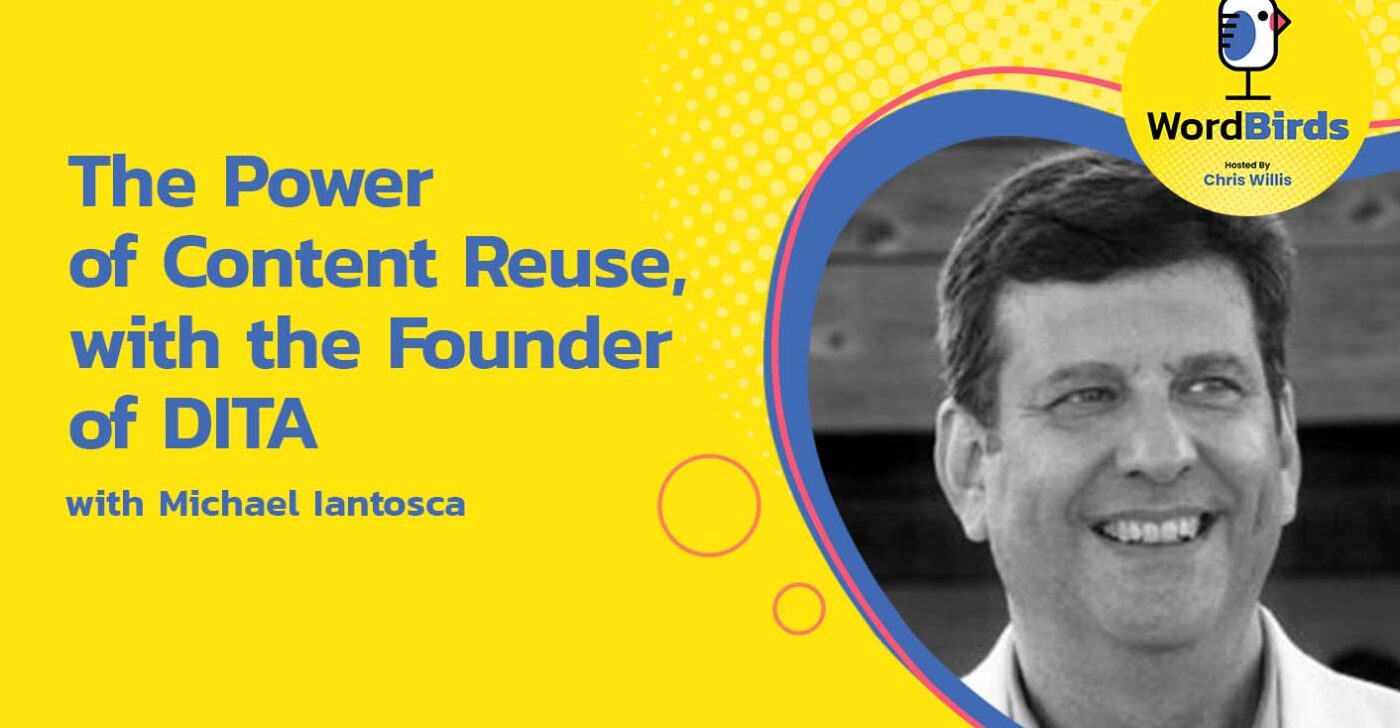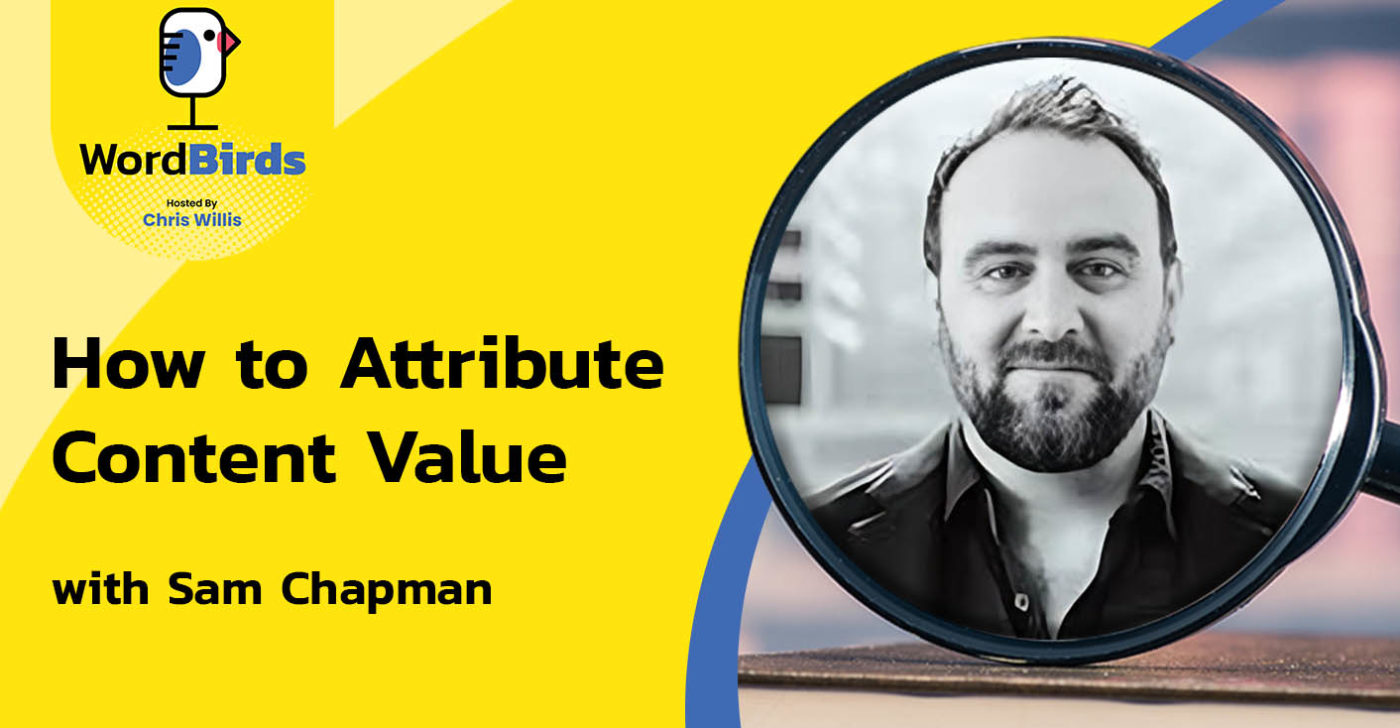After the pandemic, a lot of organizations had to rethink their content marketing strategy. With in person events out of the question, a thought leadership strategy built on quality content became a must.
Vice President of Content Strategy Wade Coleman, describes how at Fiserv they pivoted to a balanced content marketing strategy to capture the attention of their target audience. Part of that involved the creation of “invisible” content. What does Wade mean by that? You’ll have to tune in to find out.
Wade also explains why there’s a lot to be excited about when it comes to generative AI and content creation. Let’s sit back and get some insight from the flock.
Watch the episode
Listen to the episode
Read the full episode transcript
Hello Wade and welcome to the show! Excited to have you here.
Thanks Chris! Great to be here.
Let’s go ahead and jump right into this with the quick-fire questions. So I’m going to say some things and I just want you to say the first thing that jumps into your head.
Amazing content is …
Invisible.
Concise or descriptive?
It depends.
The company with the best brand voice is?
I’m going to go with, not a well-known brand, but a small brand called Brooklyn Tea.
Okay. Best piece of content advice?
Ask questions.
And when I’m creating content I always …
Think about the consumer!
Invisible. Let’s go back to that. Tell me what you mean?
I think it’s when you’re creating content that people are consuming, but they don’t know that they’re consuming marketing. That’s the stuff they pass along to their friends and send to their boss to say “Hey, we need to take a look at this!” That’s the type of content I mean. And it’s not tricky, it’s not something that’s underhanded, it’s just truly useful to people and so they forget that it’s actually marketing.
I love that! That’s fantastic.
Brooklyn Tea. Tell me a little bit about why.
Brooklyn Tea is an interesting company.
So Fiserv, my company, during the pandemic we started a grant program for small businesses. One of our big lines of businesses is the Clover Point of Sale System and what we saw was that small businesses were out-sized in impact by the pandemic.
The Walmart’s were still open, the Starbucks were still open, but it was really the small shops that suffered. So we started a grant program called “back to business,” focused primarily in the beginning on black-owned small businesses because those communities were out-sized in impact as well.
I think AI is going to be a tremendously good thing for content marketing. Click To TweetOne of our grant recipients was a company called Brooklyn Tea. They had a really small shop, one in Brooklyn, they’ve expanded to three now with two in Brooklyn and one in Atlanta. What I love about them is that the brand voice is all around a love of tea and educating people around tea. They have a digital experience and an in-store experience that’s seamless.
They’re doing all these things that you don’t traditionally think about small businesses, but they have a fantastic origin story that’s very similar to every great brand out there. The Coca-Cola’s and every company that has a story that you know. To me, they exhibit that because it’s all around tea.
It’s great when your tone of voice, your entire outreach, can be around something that you actually care about too. I imagine that’s the center of their world and they’re aligned around that center.
Exactly. A husband and wife team who are really passionate about it. And there’s a community around what they built, around tea, as well as their presence in the community. That to me exhibits what it’s all about when you’re developing a brand voice.
And a great brand is scalable, so you can grow that community just on the back of that brand. Fantastic!
So wait, you’re the Vice President of Content Strategy at Fiserv. A fintech company with a lot of different audiences. Broadly, who are you creating content for?
So at the enterprise layer we’re creating content for our merchants. So small businesses, as well as our large enterprise clients. So folks who are running the payments operations at major brands around the world, as well as financial institutions. Virtually every part of the financial institution from the front office to the back office. It’s a lot of different audiences but there’s one common thread through them all — financing in commerce itself.
You’ve already hinted at the style of the content that you create. You’re creating actionable content. You’re not just marketing to them, you’re providing them with assistance that eventually will guide them towards you.
Exactly.
I like the idea of invisible content.
I don’t know if you know Mike Volpe, the original CMO at HubSpot? But we were talking one day about his early strategy and then building their conference, the big conference they have here in Boston. And he said “I do these things with the intent of bringing people in, they may never buy my product. They might not be big enough, they might not be the right audience, but we’re building this audience around us for the eventuality that we have a product to fit them.”

So a lot of what they did throughout the time that he was there was around actionable content creation. To be assisted, regardless of who you are. Do you find that you’re able to solve problems with your content that you don’t even solve as a business that eventually brings people in?
Yeah, I think that’s a big part of it. Making sure that you’re developing something that’s not just product focused, it’s really broader than that, but it’s around this community. And within all of those groups that I mentioned we have communities that have very specific interests and things that they’re looking to solve.
When you’re developing the content programs to address those, really looking at their needs individually, what types of channels, where they’re engaging, what’s important to them, and then making sure that what you’re developing around that is authentic and really does help them.
And it depends because some of the communities that we have are pretty small, or small in context, they’re not broad consumer audiences, but they’re very interested in the inner workings of the ACH payment system. And so when you’re developing content that’s really niche like that, it does appeal to people that are broader than just your current existing client base. But at the core of it, it needs to be something that’s helpful in moving them forward.
Absolutely! And you’re in a competitive space so assisting somebody in any way gives you a much higher percentage of the possibility of bringing them back in as a customer eventually.
A hundred percent!
With the audience, I come from a traditional enterprise B2B approach where I know where to find the folks that I want to talk to. You have a much wider, more diverse audience. How are you getting to these folks? How are you building a content strategy that allows you to reach this wide audience?
I would turn it around a little bit, because that’s the consumer space that we work in, it’s more a small business audience but is really a broad consumer. And then we do have the financial services and enterprise payments parts, which are very different approaches.
My team focuses more on the enterprise brand for all of Fiserv, but then also supporting the enterprise customers. The Clover brand that we work with is very much integrated into the core of that messaging, but it’s a consumer marketing approach. On the enterprise layer, one of the things that we look at is targeting directly to our customers at our client events.
Generative AI as a solution area is super powerful, but it's just another content channel. Click To TweetBringing in a much smaller community within the broader community, having them come to our event where they’re the spokespersons, we’re bringing in outside experts talking about the industry, and we have our own people there. That community then helps catapult the content that we’re using for the rest of the year. That’s then targeted to a much broader audience outside of just that one event.
So that’s something that’s important to us from an event standpoint, in an experiential and sales process, and relationships with our clients. It really helps amplify the messaging and what we find out at that event is helpful to us for the rest of the year — to marketing to that broad community.
Oh absolutely! The lead up to any event is a hidden drain on any content organization right out of the gate. People don’t think about that.
“Oh, we’re doing a conference, it’s field marketing.” Well, kind of. It’s kind of everybody, but there’s a lot of content that’s going to drive it. But it’s also a huge test for what you’re creating. The results of which helped to guide the direction that you’re going to move in as you go forward. Because you’re seeing consumption in real time.
Are you getting feedback from folks in real time?
That’s the thing I think that’s changed within event and content marketing is that with the advent of apps and other tools where you’re on-site it both amplifies it externally, but you’re also getting real-time feedback on the session because of the mobile app that you have there.
Trying to stay relevant, but also making sure that it's not just content for engagement purposes. It needs to be a role where we're differentiating in it. Click To TweetIt used to be that everybody was using Twitter and other apps to communicate throughout the event. But now you have mobile apps that are really focused on that, which provide troves of data for using afterwards. But it’s also giving you a real-time survey on what people think about what’s happening there, based on engagement stats, direct comments, and things like that.
It’s great to get that kind of feedback. So I assume you’re bringing that back, you’re using that, and that leads your follow on content strategy. What would you say are your top tips for creating a well-rounded content strategy?
I think going back to what is important for the audience that you’re looking for, really putting yourself in their shoes, and then thinking about the broader community itself. Anyone in marketing, and anyone in this role, has experienced this when working with stakeholders, they get really locked in on “I want a podcast” or “I want to blog.” It really is based on what they feel like is important to them.
You’ve got to love what you’re doing, but at the same time, is that the right audience for who you’re trying to reach? And often it’s not and so helping walk people through what we are trying to accomplish and start with the questions on that. Who are we talking to? Building out the content plan at that high-level strategy before you hone in on the tactics I think is pretty fundamental.
From there you can be creative, you can ideate, and you can build things that people really want to consume. But if you’re building it for you versus the audience you know it’s not going to work.
Right. So I guess an interesting question is, outside of the feedback that you get from the conference, how are you gauging and measuring impact?
Or maybe the question is how are you measured? Somebody C-suite looks out the window and says how is the content organization doing, what are the key indicators that they’re looking at to gauge whether this is working or not?
I think there are the base level engagement metrics that you get from the web and other places. And that really depends on where you are in your strategy. If it’s really high-level enterprise thought leadership and your goal is to bring the wider community in, you’re looking at those broad funnel metrics.
As you hone down in the funnel, how are you converting people? What content is helping move people through the stages? I think that’s what’s interesting now is that we’re able to see more of that engagement data further on. It’s not just page views and clicks, but being able to map it back through tools like account-based marketing and other things like that.
We’re able to get more measures in there. The thing that’s always hard with measurement though is making sure that you’re connecting it to the consumers and you still get those high-level engagement metrics.
So going back and looking at the measurements in that way and understanding why. It can be AI assisted, it can be technology and data assisted. But the human part of that is looking at it with an editorial eye and understanding the audience that you're… Click To TweetThat’s the challenge because you can do things that get you results for results sake, but you also have a brand to protect.
Yes, and I think the metric discussion, you have to have it, you have to constantly be focused on it, and be talking to your leaders about it. But often, just because you can shine a light on a specific area doesn’t necessarily mean that it’s moving the needle for you.
So I think that’s where you’ve got to match the data that you’re getting, back with the critical thinking on really what is moving the needle for consumers and answer that question for your leadership.
Are you looking at results, from an iteration standpoint, and going back to your strategy drawing board? Are you looking at tone of voice, terminology, and clarity levels to tweak and dial in the performance of the content?
We’re looking at higher-level metrics than that right now. I think that’s the exciting part, are we on tone, are we on brand? With AI coming in, we’ve started to experiment with that to make sure we’re hitting those areas. But mostly we’re still looking at the higher-level metrics and then analyzing those pieces, talking about them in an editorial way, and seeing which ones are performing well.
Sometimes things that you think are going to resonate with the community and you’ve put a lot of time into, then don’t do as well as you thought they would. And then others that you just spent a little bit of time on take off.
So going back and looking at the measurements in that way and understanding why. Was it a timing issue? What factors within our distribution strategy impacted this? Can we reuse it at another time? I think those discussions are ongoing. And it can be AI assisted, it can be technology and data assisted. But the human part of that is looking at it with an editorial eye and understanding the audience that you’re trying to reach, that’s still important.
It’s not so much a question, it’s a statement: It’s terrible when you’ve built a piece of content that you think is perfect — like everything that you were looking for. It’s on-tone, and clarity, consistency, and character are all locked in, it’s the message you want to put out in the world. And it just doesn’t do anything. It’s disappointing.
If generated AI is just generating B.S. that's not going to help us. I think that’s the enemy and any content marketers job is to really shift through that and make sure you're getting things that are on-tone, on-message to your audience and getting… Click To TweetLet’s talk about thought leadership a little bit. How are you using thought leadership to drive your content experience for your audience?
It starts with understanding the audience and what we want to drive with them. We use a number of channels, but it’s really focused on our website, where we develop blogs and other thought leadership content. That’s based on issues that are important to our clients, but that also map back to what we’re hearing in the industry, and what we’re hearing from our client events.
Trying to stay relevant, but also making sure that it’s not just content for engagement purposes. It needs to be a role where we’re differentiating in it. We’re not just trying to bring in a broad audience. We want to make sure that we’re providing our brand positioning around this issue and presenting it in a way that helps people move forward with it.
Speaking of moving forward, how do you see this going forward? Where do you see Fiserv’s branded content going in the future?
I think it’s sort of “back to the future” because one of the things that happened during the pandemic was that we had this big pivot. From our events, and all the things that helped drive content strategy around that, and being able to develop blog posts and campaigns that target people that either went to our events or topics that were generated from it, to really doing everything in a digital environment.
That was a great learning experience for us. We built muscles in digital that we needed to have, because we have a very relationship and B2B enterprise focus, it made us work in different ways. But we also learned how important the experiential part was to us as well.
If you're building it for you versus the audience you know it's not going to work. Click To TweetSo now that we’re back in this environment where we have live events and that we’re connecting with our clients on that level, it’s matching what we learned during the pandemic and adding that rigor of digital understanding.
What booths people interacted with at a show, what things were they interested in the app, what are we learning from the sessions that they did attend, and how they rated them? Putting all that together and improving our digital presence so that we’re looking at each stage, each channel, and marrying all of those together.
I love that! It’s the first time I’ve heard anybody say that we made the digital shift on March 11th of 2020 when everybody went home from work and never came back.
And you’re saying “Yeah that’s great, we learned a bunch of things.” But what worked before might, and in fact does work now, so it’s taking the best of the last three years and then tacking that on top. Making it additive to the experience you built before which I think is a really neat way to look at it.
Yeah and I think it’s different for different companies and it’s different for different markets. For us that experiential relationship part is important because these are very long-term relationships.
With a financial institution they look at every aspect of it, there’s a lot of trust there. When you’re working in financial services and money, it’s different from that perspective. So understanding what we lost during the pandemic, during a digital event, is helpful in the early stages of that relationship and the ongoing maintenance for it. But nothing replaces face to face. So it’s making sure that we’re building community in digital environments, but also maintaining that in the real world.
Who are we talking to? Building out the content plan at that high-level strategy before you hone in on the tactics I think is pretty fundamental. Click To TweetNow’s the time in the show when I like to dig into things that get people worked up. It’s the Provocative Statement of the Day or PSOTD. What’s your provocative statement of the day?
I think AI is going to be a tremendously good thing for content marketing.
Go on!
The reason I say that is because it’s been fascinating to me. It goes back to this theme in the literature of Frankenstein and Blade Runner: “The robots are going to take over and they’re going to replace people.” And what is consciousness and if it’s not fully created by human beings that it’s somehow less.
When I look at AI and when I use it, I think a lot of the debate is that it’s really just a reflection of who we are. But the other piece of it is, you look at creativity and content development every time there’s a transformative technology or a new technology. People get really afraid because it’s going to be disruptive.
There’s going to be that Luddite rebellion where people are pushing back on it and legitimate issues that do come up with that. But ultimately it’s about making us better. Did Da Vinci say “I’m not going to use that type of oil in my paint.”
Of course we’re all Da Vinci’s in marketing, but the bigger issue for me is that it’s going to make us better. There are places, just like the internet where we’re going to see misuse of it, but that doesn’t mean that it’s not going to be something that’s going to be tremendously useful to us and I look forward to it.
I like that attitude because I think sitting where I sit, I work at a software company that’s involved in content governance, it would be very easy for me to be the guy in the off ramp holding the sign that says the world is ending. But that guy is nuts, he might be right, but I don’t want to be that guy, I want to find the positives.
You've got to match the data that you're getting, back with the critical thinking on really what is moving the needle for consumers. Click To TweetGenerative AI as a solution area is super powerful, but it’s just another content channel. It’s another place to get something, to solve some problems from a velocity standpoint. But it doesn’t solve all your problems and there’s still a lot to do.
I think that’s where this keeps the human element. I’m not concerned for content creators because there’s generative AI, I think they become more important than ever. Because if we don’t have people creating content, generative AI will eventually start telling its own story and that story won’t be very interesting.
If generated AI is just generating B.S. that’s not going to help us. I think that’s the enemy and any content marketers job is to really shift through that and make sure you’re getting things that are on-tone, on-message to your audience and getting results. That’s not going to come from generating a lot of material and so having the human element involved in it is absolutely critical.
Wade, thanks very much for being on the show! Looking forward to getting you back on in the future. Have a great rest of your day!
Thanks Chris, I really enjoyed it!
Important links
- Wade Coleman – LinkedIn
- Fiserv
- WordBirds – LinkedIn
- WordBirds – Home page



